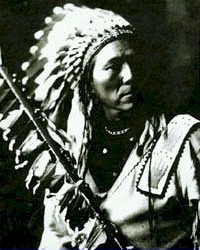For thousands of years the Coeur d'Alene Indians have lived
in the Northern Idaho and Eastern Washington along the Spokane
River Basin. Unlike the tribes of the plains, the Coeur d'
Alenes and their neighbors, the Spokanes, the Kootenai, the
Kalispell, the bands of the Colville Confederated Tribes and the
Kootenai-Salish, or Flatheads, were not nomadic.
Morris Antelope an Coeur D'Alene Indian Chief.
 |
Coeur d' Alene Indian villages were established along the
Coeur d' Alene, St. Joe, Clark Fork and Spokane Rivers. French
fur traders named the tribe Coeur d'Alene--"heart of an
awl"--saying they were the finest traders in the world. The
tribe's trade involved year-long trips to the Pacific coast as
well as to the Great Plains to exchange goods. They called
themselves Schee chu'umsch, which, in their native Salish
language, means "those who are found here."
The Coeur d'Alene Indians lived in large permanent villages
along the Spokane and St. Joe Rivers, near Lake Coeur d'Alene
and Hayden Lake and on parts of the large prairie known today as
the Palouse country, an area of about 5 million acres. They
enjoyed a close relationship with the inland tribes of Canada
and the Northwest, sharing a common language and fishing
grounds, intermarrying, and attending big trade gatherings and
celebrations. Silver was discovered in the Idaho panhandle in
the 1870s, setting off a frenzy of mining activity. The Coeur
d'Alene Indian Reservation, established in 1873, originally
included all of Lake Coeur d'Alene. By a series of treaty
agreements, the reservation was reduced to its present size.
Ancient trade routes connected the Coeur d' Alenes with the
Nez Perce, the Shoshones and the Bannocks to the south and
southeast. To the east were the tribes of the Great Plains and
the vast herds of buffalo. With the coming of horses, young
Coeur d' Alene men journeyed east to hunt buffalo. These
journeys, however were not necessary for survival. The Saint Joe
River was plentiful for whitefish in the late fall and the
Spokane River in the summer provided large amounts salmon. The
jpourneys were viewed as adventures, with rites of passage, for
youth who would step into manhood and then on to leadership
roles.
The first white people to encounter the Coeur d' Alenes were
French trappers and traders. It was one of these Frenchmen who
found the tribe to be vastly experienced and skilled at trading,
thus the name "Coeur d' Alene, "meaning "heart of the awl." The
nickname stuck. One Frenchman described the tribe as "the
greatest traders in the world."
The Coeur D' Alene area is also home to one of the first
Catholic missions to be established in the West.
Cataldo
Mission was originally established on the St. Joe River in
the early 1840s. Because of flooding the mission was moved to a
bluff overlooking the Coeur d'Alene River in 1848. Today the
mission remains Idaho's oldest building. Both the mission and
the parish are part of Old Mission State Park.
The Coeur d'Alene Indian Reservation is located south of the
resort town of Coeur d'Alene in Idaho's panhandle and only
occupies a fraction of the tribe's original 5,000,000 acres. The
arrowhead-shaped reservation includes the edge of the western
Rockies, half of Lake Coeur d'Alene, and portions of the fertile
Palouse country.
Adjacent to the Reservation is Steptoe Butte, the highest
point in the Palouse (towering more than 1,000 feet above the
valley floor) and one of the most important sacred sites of the
Coeur d'Alene. Its peak was a site of meditation, prayer, and
ceremony for centuries. The butte, covered with downy grass, is
solid rock, 500 million years old.



